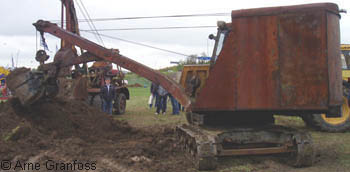Norwegian police in Sweden

 UNDER CONSTRUCTION Version 0.32
UNDER CONSTRUCTION Version 0.32
|
Sweden in World War II - across borders
|
 |
![]()
![]()
There were 20,000 Norwegians in Sweden when 1944 began, of which 13,000 men of military age. Many of them had come to Sweden in the hope of further transport to the Norwegian forces in Britain, but these were sparse. They could not get military training in neutral Sweden. [s58]
From private discussions between some Norwegians and Swedes emerged the idea to give them police training. With among others physical training and instructions in the use of small arms, they could be used as a police and security corps if Germany capitulated in Norway. [s58]
Plans were made, with partly different agendas, between not so many persons. In the second half of 1943 more than 8,000 Norwegians were summoned to "health camps", for among others medical examination. [s58]
On 3 December 1943 the Swedish government gave permission for training of 1,500 Rikspoliti (national police) and 8,000 Reservepoliti (police reserve). The men had to be volunteers. Initially the training was kept in secrecy as far as possible. [s58]
Around the end of the year the set up of the Rikspoliti companies was almost finished. [s58]
On 15 January 1944 the Reservepoliti began their training. [s58]
After some time the limited training, with among others training in use of small arms only in a few of the camps, led to lower motivation and poor discipline among the men who wanted to fight the Germans who occupied their country. The situation changed when the second half of 1944 began. In August large-scale maneuvers took place, and in September the number of camps with weapons instructions grew - and they also had training in some heavy arms. The number of Reservepoliti became 12,000. [s58]
From February 1945 these Norwegians were allowed to wear their uniforms also outside the camps. In April 6,000 Norwegian policemen took part in field maneuvers in Sweden (the largest Norwegian field maneuvers since 1918). [s58]
![]()
In the autumn of 1943 the training of Norwegian "police corps" went on, in a scale that was larger than most Swedish ministers knew of and/or had intended. At the end of 1943 Norway had been allowed to train 1,500 men in a police corps and 8,000 men as reserve police. They received arms for a third of these numbers. [s58]
![]()
Birkeland was one of the men working in the resistance in western Norway. In late November 1942 he was close to be arrested by Gestapo, one of them even had got hold of him when he managed to get loose and run away without being hit by bullets. He decided to hide in the mountainous area instead of leave for Sweden as so many others in his situation. During the autumn 1943 he went to Sweden, called there to help with the education of the Norwegian 'police force' in Sweden. [s46]
![]()
![]()
From 3 December 1943 Norwegian refugees were allowed by the Swedish authorities to be placed in special camps. There they were educated to become policemen. But, actually it was
military education. 13 500 Norwegians were educated. Some of them were sent to northern Norway when the German troops retreated from the area. [s19]
![]()
![]()
The Norwegian police corps were not allowed to go to Norway without permission from Sweden. [s58]
In October 1944 Sweden said ok for 2-3,000 men to be moved to northern Norway, an area the Germans withdrew from. As the German troops retreated from Finland and southwards in Norway, they evacuated 59,000 Norwegians who lived in northern Norway. Everything was destroyed by the Germans. [s58]
On 18 October 1944 Soviet Union troops entered northern Norway, but halted at Kirkenes close to the border. The first Norwegian soldiers, 271 men, arrived from Scotland on 10 November. It wasn't until after the new year that the first of the police corps arrived in northern Norway, but only 1,300 were sent there altogether. [s58]
From January 1945 USA planes transported 1300 Norwegian police troops from Sweden. [s51]
![]()
When the war ended in Norway, 14,700 Norwegians had received "police training" in Sweden.
The Norwegian military resistance organisation Milorg had around 40,000 men in Norway, and the Norwegian Brigade educated in Scotland numbered 4,000 men. [s58]
When May 1945 began, there were some 350,000 well-equipped and well-trained German soldiers in Norway, with air and naval support. [s58]
![]()
An advance troop of Norwegian police troops, led by a Swedish officer, blew up a German road block at the border and entered Norway by the time the German forces in Norway had capitulated. Some German soldiers were passive onlookers. [s50]
![]()
The rest of the Norwegian police troops, who were trained and equipped in Sweden, were transported to Norway on 11 May 1945. [s03]
![]()
A Norwegian stone in Stockholm.

"Thanks from Norway for the education of 14,700 police soldiers in Sweden during the second world war". (My translation)
2013-10-27. www.granfoss.se. Text/pictures: Arne Granfoss